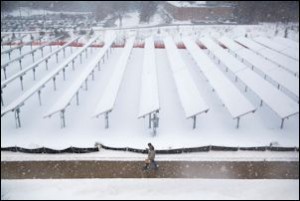by James A. Bacon
At 8 a.m. on Jan. 8, 2015, Dominion Virginia Power (DPV) supplied a record 19,870 megawatts of electric power to its 2.5 million customers — beating the previous record, set the year before, by 85 megawatts. That news bit comes from a DPV e-newsletter with no particular ax to grind. Temperatures in Richmond, you may recall, fell to 12° F that day.
Now, let’s perform a thought experiment similar to the one that Investors Business Daily did for Boston.
What if environmentalists had convinced Boston city officials that fossil fuels were destroying the planet and that renewable energy sources could supply the city’s needs both in electricity generation and for powering city vehicles?
The past several weeks have seen back-to-back winter snowstorms in New England, as well as much of the Midwest, with plunging temperatures and seven feet of snow already in many parts of Massachusetts. So how would the city fare under a green energy-only policy? …
Let’s begin with heating. Bostonians wouldn’t be able to use heating oil or natural gas because those are fossil fuels, so electricity would most likely depend on wind and solar. But when snowstorms keep coming, there’s very little sunshine, and acres of solar panels would likely be covered in snow.
The picture for wind power is different from solar. Cloudy days don’t dim the production of wind power. But major storms do. Wind turbines are shut down when winds hit high speeds, say, 45 miles per hour or more. Check out the video above to see what happens to wind turbines in high winds. Its’ really cool!
Virginia has a voluntary Renewable Portfolio Standard (RPS) that sets a goal for Virginia power companies to generate 15% of their electricity from renewable sources (solar, wind, biomass, hydro) by 2025. Environmentalists have supported increasing the goal to 25% and making it mandatory.
Ironically, one of the things that increasingly concern environmentalists is “extreme weather events” precipitated by global warming. Warming, we are told, will lead to more heat waves, more drought, more hurricanes and more disruption of the jet stream with concomitant extreme bouts of polar cold. We need more renewable energy, they say, in order to reduce the carbon dioxide emissions that supposedly drive this climate change. Yet renewable energy — particularly solar and wind — are the most likely to fail during extreme weather events.
Right now, with renewables constituting one or two percent of Virginia’s power portfolio, DPV, Appalachian Power and the electric co-ops have an adequate safety margin to accommodate fluctuations in renewable supplies. But extreme weather events like polar-express cold waves are coupled with extreme demands for electricity. If renewables constituted 25% of the energy portfolio, could Virginia electric utilities keep the heat pumps running? And if they couldn’t, how many people would freeze to death?
These are serious questions. If there is to be a serious discussion about mandating a 25% RPS standard, issues of system reliability must be addressed. If environmentalists want to be taken seriously on this issue, they need to propose solutions. Perhaps there are solutions. If so, I haven’t heard them. But they need to be packaged with RPS legislation, or we risk bringing upon ourselves the very calamity we seek to avoid.



